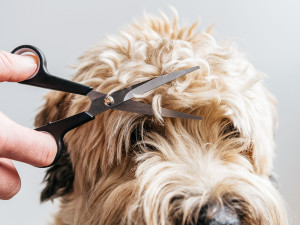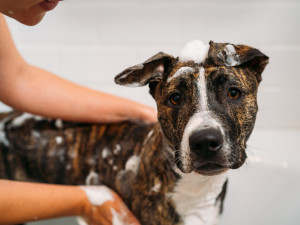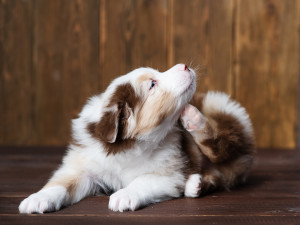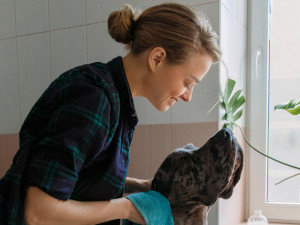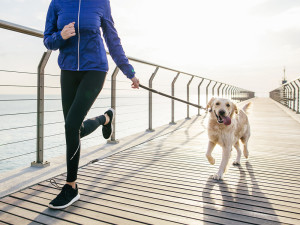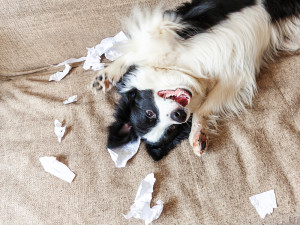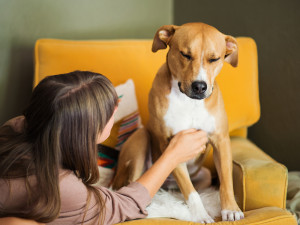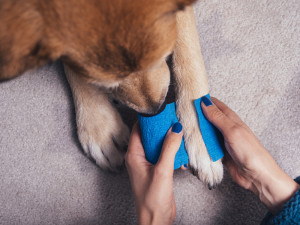Tips On How to Brush and Bathe Your Dog From a Pro
Groomer Robyn Michaels explains how to keep your pup well-groomed
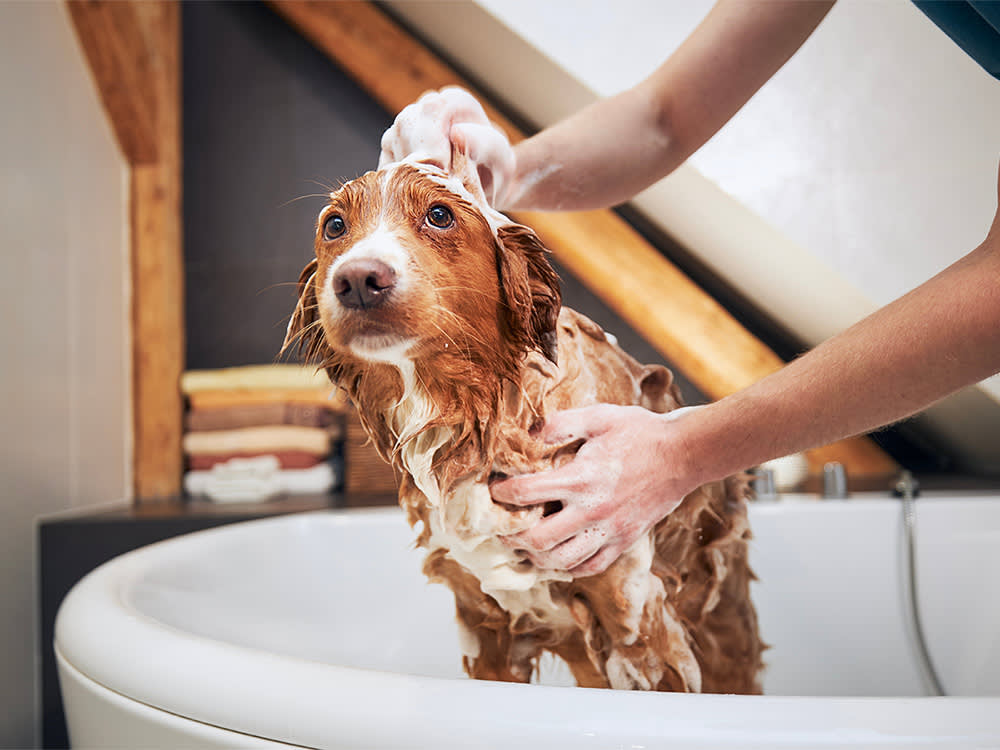
Share Article
It seems so simple. A few passes with a brush, an occasional suds-up in the tub or garden, and there you have it: a well-groomed dog. If only.
But don’t worry: professional groomer Robyn Michaels is here to help. Read on for the best brushing techniques, grooming tools and general tips to keep your dog looking and smelling good with minimal fuss.
How should you brush a dog?
The best way to brush a dog is simple: “Start at the same place on your dog every time – it’s best to begin at the bottom of the back legs – and work your way up, first one side, then the other,” says Robyn. As you’re brushing, it’s important to brush the dog from the skin out, getting down to the skin level. “If you don’t get down to the skin, you will not be doing a thorough job. Plus (especially if the dog gets wet), the hair may mat, which happens when open hair cuticles lock together.”
Getting skin deep is especially important for dogs with double coats. “If your dog has a double coat (long guard hairs and a shorter, softer undercoat), you need to get down to the skin to remove that loose undercoat hair,” recommends Robyn. She notes that matting starts in a dog’s moving parts – “around the tail, behind the ears, in the armpits, and on the hocks and pasterns (ankles), and spreads from there.”
How often should you brush a dog?
The frequency of brushing depends on the type of dog you have. “You may have to brush them every other day if your dog has a dry, cottony coat (like a Coton de Tulear),” says Robyn. But you don’t want to over-brush your dog either. “For most dogs, if you brush too often, you will cause more static, which will cause more matting and also affect the coat’s shed cycle.”
While you don’t want to over-brush them, you do want to stop matting. “Brush at least the mat-prone areas every week; and a long-haired, double-coated dog usually needs to be brushed more often when they’re actively ‘blowing coat’ – the big twice-a-year seasonal shed.” One more thing: dressing up your dog may be fun, but if you have a single-coated dog, every time you take off their coat or sweater, you create static that causes matting.
Does brush type matter?
If you feel like no matter how often you brush your dog, they still don’t look well-groomed, and you still see tumble-weeds of dog hair rolling across the floor, you’re probably using the wrong dog grooming brush. “The best-selling dog brush in America has bristles on one side and pins on the other. Unfortunately, this is the wrong brush for more than 95 percent of pet dogs. Or maybe 100 percent – I have yet to find a groomer who can tell me the breed or coat type for which they use this type of brush,” says Robyn. These brushes are commonly seen at local pet shops, and often, unknowing pet shop staff recommend them simply because they sell well. But they don’t work well. “Both the pins and the bristles bounce off the top of the dog’s coat and do very little to remove loose hair.”
So, which dog grooming brush should you used?
The best dog brush for most breeds is a slicker brush. “Just about any will do. I use two curved slickers: one called a ‘stiff’ slicker and one with finer-gauge wire. You may find others easier to use,” says Robyn. She recommends those over a flat slicker because the wires on a flat slicker have a tendency to straighten as you brush. “When the wires become straight (or are bent in the wrong direction), the brush is useless,” she says.
Another recommended brush is a rake which comes with various numbers of teeth in a row. “I suggest that you get one with the widest separation/fewest teeth. The blades on the underside of the curved teeth act like seam rippers. It is almost impossible to cut your dog with this type of rake, and you will pull out a lot of hair that a slicker brush won’t get.” Lastly, a metal comb is also handy to have. It is useful to tease out mats, get into small areas (under armpits, behind and under ears, between toes) and clean the brush.
Is it OK to shave a double-coated dog?
Robyn doesn’t recommend shaving a double-coated dog. “Shaving double-coated dogs changes their coats. The hair grows back very slowly and is likely to be shorter and softer, and possibly a different colour.” Worse, shaving a double-coated dog can lead to a troubling skin condition. “The dog may develop clipper alopecia, in which the hair does not grow back at all,” she says. While it might seem easier than dealing with all that brushing, it’s good to remember that it doesn’t take as long as you might think. Brushing with the proper brush should take “less than 15 minutes once a week. In many cases, it will take less than five minutes.”
What’s the best way to help a dog enjoy being brushed?
If you have a puppy, start grooming them the first day, even if they don’t need to be brushed. “It’s best to have the pup lie down, as that allows you to do a more thorough job and not break the coat – meaning that the coat could actually ‘break’ and get split ends, causing matting. This is very important for Tibetan Terriers, Afghan Hounds and Shih Tzus, for example.” Older dogs that are not used to being groomed will take more time; they may panic. The main thing is to be patient and work with the dog on their level, a little at a time.
“A grooming table makes all the difference. Being even a foot off the floor puts your dog in a different dimension and a different place psychologically. You can buy a used portable dog grooming table or make your own,” says Robyn. Teaching your dog basic obedience exercises will make a huge difference, which helps your dog cooperate and lets them know it won’t hurt them.
Let’s talk about bath time
There are many kinds of dog shampoo during bath-time, so you should be able to find one that works well for your particular dog’s coat. But know this: “Suds do not clean the dog.The shampoo’s active ingredients agitating against your dog’s hair is what does the cleaning. If your dog’s skin is irritated by a shampoo, it’s usually sodium laureth sulphate (or chloride, the sudsing agent) that’s causing the problem. A few manufacturers make sodium-free shampoo,” says Robyn.
How much soap should you be using on your dog?
Michaels recommends diluting your dog’s shampoo. “If you don’t dilute the shampoo, you’ll never get it completely rinsed out. The industry-average dilution rate is 16 to one, but you can just eyeball it.” You can keep pre-diluted shampoo in an old shampoo bottle for easy access.
If the suds don’t clean the dog, how do you know when enough is enough? “You want just enough suds to tell you when you’ve covered the whole dog. If you want to really get the dog clean, brush the shampoo through their coat. This covers every hair, gets out some of the smaller tangles you might have missed, and removes the loose stuff.” Once the bath is done and the dog is dry, brush them again. “Then float a comb through their coat to finish up and clear out any remaining tangles,” adds Robyn. Don’t forget: armpits, behind the ears, under the chin, and around the tail and ankles.
What about conditioners for pups?
If you’ve ever considered using a conditioner on your pup, think again. “I rarely use them. A conditioner works by coating the dog’s hair with a humectant, which attracts moisture. This can be helpful for long-haired dogs in the winter, to counter static, but conditioner is difficult to rinse out, often leaves a film on the dog’s hair, will attract dirt and may even cause matting,” says Robyn. Avoid conditioners unless you are using them for a specific reason recommended by your groomer.
Susan Tasaki
Freelance writer Susan Tasaki lives in the San Francisco Bay Area with her Husky, who wishes they both got out more.
Related articles
![Fluffy brown and white puppy dog scratching a lot with its paw]()
Your Itchy Dog Deserves Relief – Here’s What to Do
How you can help them feel better – fast
![Smiling woman wiping ears of dog]()
Should You Clean Your Dog’s Ears at Home?
Heed all those cautionary tales about cotton buds
![A dog running with a woman on a pier.]()
8 Questions to Ask Yourself When Choosing a Dog Breed
Find out which dog breed is right for your lifestyle
![Puppy laying in torn up paper on the couch]()
New Puppy Driving You Nuts? Here’s How to Deal With It
The beginning of puppy parenthood can be rough, but it does get better – especially when you implement this advice
![A pet parent checks their dog's stomach.]()
DIY Physical Exam – How to Examine Your Dog’s Stomach and Skeleton
Veterinarian Dr Shea Cox on how to properly examine your dog’s stomach and musculoskeletal system
![bandaging dog's bleeding paw]()
How to Handle the Sight of Blood on Your Pet
Don’t freak out. Emergency room veterinarian Dr Shea Cox will walk you through what to do

